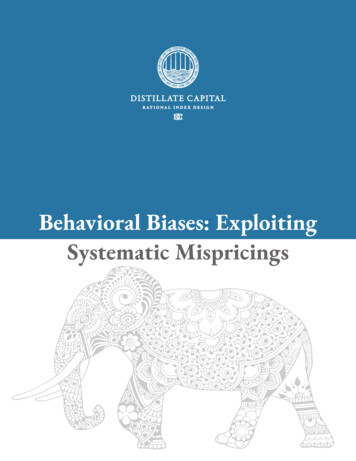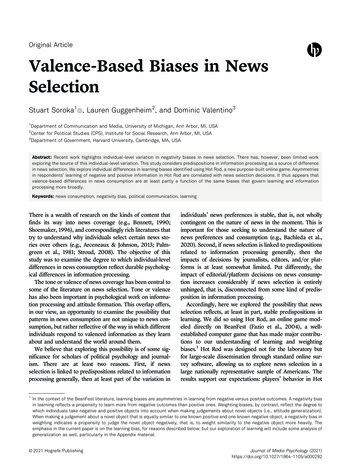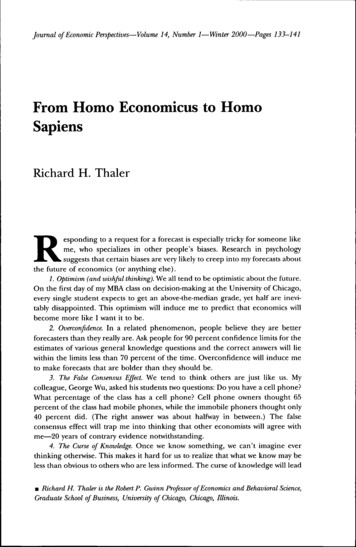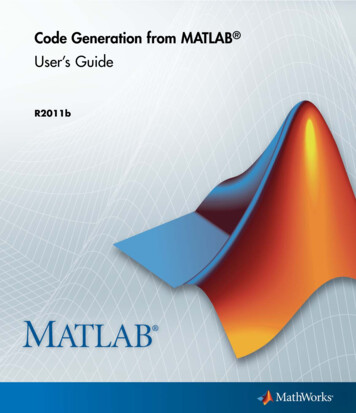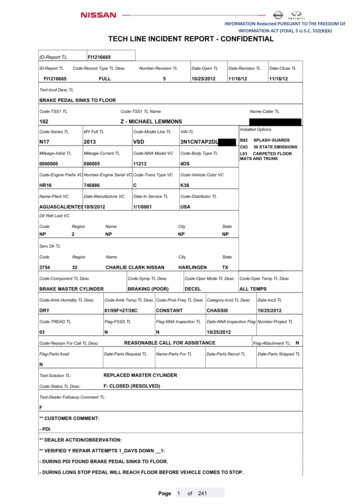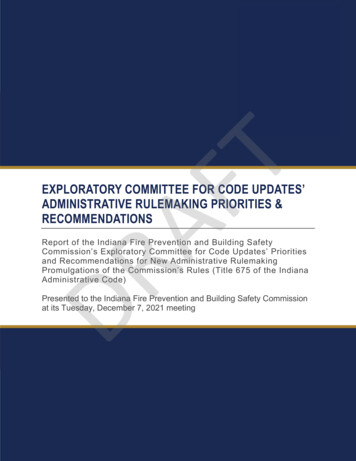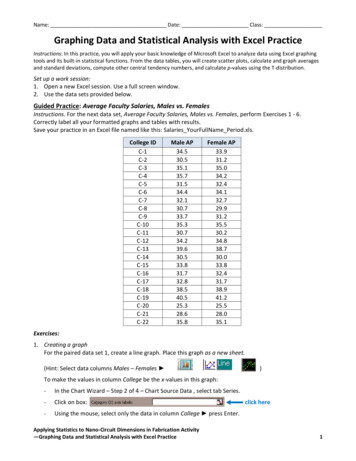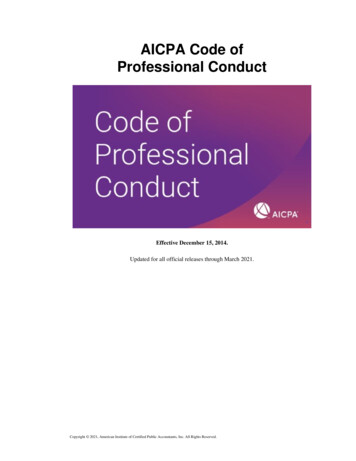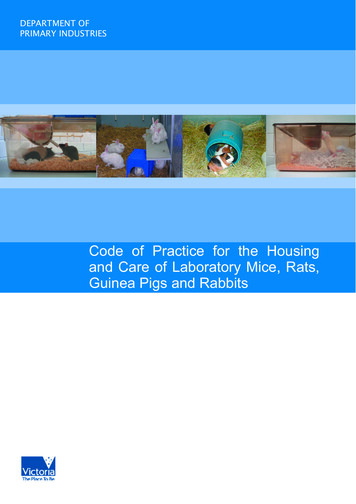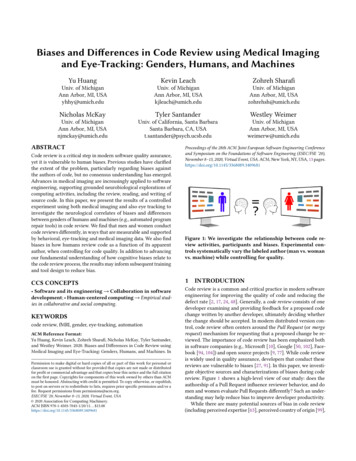
Transcription
Biases and Differences in Code Review using Medical Imagingand Eye-Tracking: Genders, Humans, and MachinesYu HuangKevin LeachZohreh SharafiUniv. of MichiganAnn Arbor, MI, USAyhhy@umich.eduUniv. of MichiganAnn Arbor, MI, USAkjleach@umich.eduUniv. of MichiganAnn Arbor, MI, USAzohrehsh@umich.eduNicholas McKayTyler SantanderWestley WeimerUniv. of MichiganAnn Arbor, MI, USAnjmckay@umich.eduUniv. of California, Santa BarbaraSanta Barbara, CA, USAt.santander@psych.ucsb.eduUniv. of MichiganAnn Arbor, MI, USAweimerw@umich.eduABSTRACTCode review is a critical step in modern software quality assurance,yet it is vulnerable to human biases. Previous studies have clarifiedthe extent of the problem, particularly regarding biases againstthe authors of code, but no consensus understanding has emerged.Advances in medical imaging are increasingly applied to softwareengineering, supporting grounded neurobiological explorations ofcomputing activities, including the review, reading, and writing ofsource code. In this paper, we present the results of a controlledexperiment using both medical imaging and also eye tracking toinvestigate the neurological correlates of biases and differencesbetween genders of humans and machines (e.g., automated programrepair tools) in code review. We find that men and women conductcode reviews differently, in ways that are measurable and supportedby behavioral, eye-tracking and medical imaging data. We also findbiases in how humans review code as a function of its apparentauthor, when controlling for code quality. In addition to advancingour fundamental understanding of how cognitive biases relate tothe code review process, the results may inform subsequent trainingand tool design to reduce bias.Proceedings of the 28th ACM Joint European Software Engineering Conferenceand Symposium on the Foundations of Software Engineering (ESEC/FSE ’20),November 8–13, 2020, Virtual Event, USA. ACM, New York, NY, USA, 13 e 1: We investigate the relationship between code review activities, participants and biases. Experimental controls systematically vary the labeled author (man vs. womanvs. machine) while controlling for quality.CCS CONCEPTS1 Software and its engineering Collaboration in softwaredevelopment; Human-centered computing Empirical studies in collaborative and social computing.Code review is a common and critical practice in modern softwareengineering for improving the quality of code and reducing thedefect rate [2, 17, 24, 48]. Generally, a code review consists of onedeveloper examining and providing feedback for a proposed codechange written by another developer, ultimately deciding whetherthe change should be accepted. In modern distributed version control, code review often centers around the Pull Request (or mergerequest) mechanism for requesting that a proposed change be reviewed. The importance of code review has been emphasized bothin software companies (e.g., Microsoft [10], Google [50, 102], Facebook [94, 104]) and open source projects [9, 77]. While code reviewis widely used in quality assurance, developers that conduct thesereviews are vulnerable to biases [27, 91]. In this paper, we investigate objective sources and characterizations of biases during codereview. Figure 1 shows a high-level view of our study: does theauthorship of a Pull Request influence reviewer behavior, and domen and women evaluate Pull Requests differently? Such an understanding may help reduce bias to improve developer productivity.While there are many potential sources of bias in code review(including perceived expertise [63], perceived country of origin [99],KEYWORDScode review, fMRI, gender, eye-tracking, automationACM Reference Format:Yu Huang, Kevin Leach, Zohreh Sharafi, Nicholas McKay, Tyler Santander,and Westley Weimer. 2020. Biases and Differences in Code Review usingMedical Imaging and Eye-Tracking: Genders, Humans, and Machines. InPermission to make digital or hard copies of all or part of this work for personal orclassroom use is granted without fee provided that copies are not made or distributedfor profit or commercial advantage and that copies bear this notice and the full citationon the first page. Copyrights for components of this work owned by others than ACMmust be honored. Abstracting with credit is permitted. To copy otherwise, or republish,to post on servers or to redistribute to lists, requires prior specific permission and/or afee. Request permissions from permissions@acm.org.ESEC/FSE ’20, November 8–13, 2020, Virtual Event, USA 2020 Association for Computing Machinery.ACM ISBN 978-1-4503-7043-1/20/11. . . UCTION
ESEC/FSE ’20, November 8–13, 2020, Virtual Event, USAYu Huang, Kevin Leach, Zohreh Sharafi, Nicholas McKay, Tyler Santander, and Westley Weimerand reviewer fatigue [82]), of particular interest are biases associated with the perceived gender of the author. These are relevantfrom a moral perspective (e.g., broadening participation in computing [11]), from a process efficiency perspective (e.g., arriving at thecorrect code review judgment [16]), and even from a market perception perspective (e.g., recent scandals involving gender-fairnessin hiring and development processes [20, 101]).Prior Work. Previous studies have shed light on the effects ofgender bias in software development by analyzing behavioral data.For example, large-scale analyses of GitHub Pull Request data foundthat women’s acceptance rate is higher than men’s when their gender is not identifiable, but the trend reverses when women showtheir gender in their profiles [91]. Similarly, another study usingbehavioral data on GitHub found that women concentrate theirefforts on fewer projects and exhibit a narrower band of accepted behavior [43]. Furthermore, research has shown that developers maynot even recognize the potential effects of biases of code authorswhen performing code reviews [27, 91]. Such biases may not onlydecrease the quality of code reviews, but also the productivity ofsoftware development, especially in fields like software engineeringthat are dominated by men [40, 78, 105] despite (gender) diversitysignificantly positively influencing productivity [12, 37, 73, 99].Moreover, not all code changes are generated by humans. In thelast decade, there has been a flurry of research into AutomatedProgram Repair (APR) tools in both academia and industry [32, 66].Recently, APR tools have seen increased adoption among larger(e.g., Facebook’s SapFix [62]) and smaller (e.g., Janus Manager [36])companies. However, many developers express reluctance aboutincorporating machine-generated patches into their code bases [56]and expert programmers are less accepting of patches generatedby APR tools [81]. In such situations, human biases may interfere with the potential business benefit associated with the carefuldeployment of such automation [32, 36, 62, 95].Unfortunately, research studying how developers perceive andevaluate patches as a function of their provenance (i.e., source orauthor) has been limited. Although the software engineering community has realized the importance of overcoming the negativeeffects of bias [37, 99], we still lack a fundamental understanding of how bias actually affects the cognitive processes in codereview. This lack of objective basis in understanding bias hindersthe development and assessment of effective strategies to mitigateproductivity and quality losses from biases in code review.In the psychology literature, researchers have explored the effects of bias in myriad daily life scenarios. For example, behavioralstudies have revealed biases in gender and race in fields such asthe labor market [1], self-evaluations of performance [8], publication quality perceptions and collaboration interest [54], onlineproduct reviews [44] and peer reviews [47, 64, 93]. Furthermore,psychologists have also adapted medical imaging techniques toinvestigate the cognitive processes associated with bias in different activities. In controlled experiments of using medical imaging techniques, psychologists have found several specific brainregions that are associated with bias in humans’ cognitive processes [6, 14, 15, 18, 33, 46, 58, 75]. These psychology studies providea model for the investigation of the behavioral and neurologicaleffects of biases in software development tasks.Experimental Approach. Our experiment involves measuringhumans as they conduct code review. In particular, we make use ofa controlled experimental structure in which the same code changeis shown to some participants with one label (e.g., written by aman) but is shown to other participants with a different label (e.g.,written by a woman or machine). Beyond measuring behavioraloutcomes (e.g., whether or not the change is accepted, how longthe review takes, etc.), we also use functional magnetic resonanceimaging (fMRI), which enables both the analysis of neural basesunderlying code review activities and also the inference of biases(if they exist).However, fMRI does not provide significant evidence about participants’ visual interaction with the code itself. We build on previous work and address this problem by capturing participants’ attention patterns and interaction via eye-tracking, which has been usedto understand developers’ visual behavior in code reading [7, 87, 96]as well as the impact of perceived gender identity in code review [27]. Using eye-tracking in combination with fMRI allowsassessing both neural activity and higher-level mental and visualload in human subjects as they complete cognitive tasks.We desire an understanding of code review that (1) explicitly incorporates gender bias, (2) is based on multiple types of rigorous physiological evidence, and (3) uses controlled experimentation to providesupport and guidance for actionable bias mitigations. Previous studies have considered these goals pairwise, but not all simultaneously.For example, there have been behavioral studies in both computerscience and psychology on biases (e.g., [1, 43, 91]), medical imagingstudies of biases in psychology (e.g., [14, 33]), eye-tracking studies of biases [27], and eye-tracking [71, 85] and medical imagingstudies [26, 41, 88] of other factors in computer science. However,to the best of our knowledge, we present the first experimentallycontrolled study investigating biases in computing activities bymeasuring multiple neurophysiological modalities.Contributions. We present the results of a human study involving 37 participants, 60 GitHub Pull Requests, three provenancelabels (man, woman, and machine), fMRI-based medical imaging,and eye-tracking. Men and women participants conduct code reviews differently: Behaviorally, the gender identity of the reviewer has a statistically significant effect on response time (p 0.0001). Using medical imaging, we can classify whether neurologicaldata corresponds to a man or woman reviewer significantlybetter than chance (p 0.016). Using eye-tracking, we find that men and women have differentattention distributions when reviewing (p 0.005).In addition, we find universal biases in how all participants treatcode reviews as a function of the apparent author: Participants spend less time evaluating the pull requests ofwomen (t 2.759). Participants are more likely to accept the pull requests of womenand less likely to accept those of machines (p 0.05). Even when quality is controlled, participants acknowledge abias against machines ( 3 ), but do not acknowledge a genderbias (even as evaluation and acceptance differ).We also make our dataset available for analysis and replication.
Biases and Differences in Code Review using Medical Imaging and Eye-Tracking: Genders, Humans.2BACKGROUND AND RELATED WORKIn this section, we provide background on code review as wellas relevant material on bias, medical imaging, eye-tracking, andautomated program repair.2.1Code ReviewChange-based code review is one of the most common softwarequality assurance processes employed in modern software engineering [2, 3, 17]. Prior work has studied the mechanisms and factorsbehind acceptance or rejection of Pull Requests, such as transparency for distributed collaborators of large-scale projects [19],socio-technical associations [92], and impression formation [63].While such post factum studies advance our understanding of codereview, they do not provide first-hand observation of the decisionmaking process involved. Other studies have used medical imagingor eye-tracking methods to shed some light on the cognitive processassociated with code review (cf. Section 2.2). In this paper, we useboth fMRI and eye-tracking to provide a more granular understanding of the cognitive process behind the code review by observingboth the reported and measured biases on carefully-labeled stimuli.2.2Medical Imaging and Eye-Tracking for SEBroadly, there is significant interest in using physiological measurements, such as medical imaging or eye-tracking, to augmentbehavioral (e.g., “did you accept this patch?”) and self-reported (e.g.,“what influenced you?”) data with more objective assessments.Functional magnetic resonance imaging (fMRI) is a non-invasive,popular, high-fidelity medical imaging technique [29]. fMRI admitsmodeling and monitoring of neurological processes by observingthe relative change in neuronal blood-oxygen flow (the hemodynamic response) in the brain as a proxy for neural activity [52].While fMRI has a rich history in the field of psychology, its presence in software engineering has been much less pronounced. Following pioneering work by Siegmund et al., about a dozen studiesin major software engineering venues have used fMRI to investigatesoftware engineering activities [13, 23, 25, 26, 41, 42, 69, 72, 88, 89].We follow this line of work, leveraging fMRI to investigate bias incode reviews.fMRI studies analyze differences in time series data collectedwhile participants complete a cognitive task (e.g., code comprehension, decision-making). For example, brain activity for a participantat rest can be compared against that participant’s brain activitywhile completing a task. Doing so allows isolating confoundingsources of brain activity (e.g., motor cortex activity from movingthe lungs to breathe). fMRI study design requires careful consideration as brain activity is inferred from blood oxygenation overtime, which is an inherently noisy signal. When a region of thebrain is engaged in a cognitive activity, it consumes more oxygen.However, the body’s physiological response to increased activity isdelayed for a brief period of time — this hemodynamic lag is wellunderstood and modeled using the hemodynamic response function.Brain activity can be compared to determine when a brain regionis implicated in a cognitive task.Modern eye-tracking is unobtrusive and provides a reliable recording of eye gaze data [71, 85]. Eye trackers capture a participant’s visuospatial attention in the region of highest visual acuity (fovea) [45,ESEC/FSE ’20, November 8–13, 2020, Virtual Event, USA76]. Visual attention triggers the mental processes required forcomprehending and solving a given task, while cognitive processesguide the visual attention to specific locations. Thus, by providinga dynamic pattern of visual attention [5, 49], eye-tracking offersuseful information to study the participant’s cognitive processesand workload while performing tasks [30, 76]. The data recordedconsists of a time series of fixations (stable state of eye movementlasting approximately 300ms), and saccades (rapid movement between fixations lasting approximately 50ms). Cognitive state istypically inferred from a combination of fixations, saccades, pupilsize variation, blink rates, and paths of eye movement over a visualstimulus [49, 74]. Researchers usually define areas of interest (AOIs)within a stimulus—eye-tracking data can then be used to measurewhen and for how long a subject’s eyes focus on a specific area.A handful of eye-tracking studies investigated the viewing strategies of developers while performing a code review task. Uwanoet al. [96] conducted a code review experiment of C programs toanalyze the gaze patterns of developers performing the task. Theyreported that a complete scan of the whole code helps studentsto find the defects faster. Sharif et al. replica ted Uwano et al.’sstudy and reported the same results while discussing the impactof expertise. In the same vein, Begel et al. [7] performed an eyetracking study with professionals working on 40 code reviews todetect suspicious code elements, while reporting similar findings ofcode reading visual patterns. Ford et al. [27] studied the influenceof supplemental technical signals (such as the number of followers, activity, names, or gender) on Pull Request acceptance via aneye tracker. We follow practices established by Ford et al. in ourstudy—however, we present a combination of behavioral, medicalimaging, and eye-tracking measurements. In our study, we measurehow participants review proposed code changes in Pull Requestsand the faces of their authors.This paper is the first study to employ both fMRI and eyetracking to observe potential bias in code review. Conversely, whilethere have been multiple studies in the field of software engineeringdealing with bias, none have employed two psychophysiologicalmodalities to achieve their goals.2.3Gender Biases and DifferencesPrevious studies have found that the field of software engineeringhas very low participation from women [79]. This is in spite of multiple studies that have found a positive correlation between teamdiversity and team performance in this field [12, 37, 73]. Severalcandidate explanations for low participation among women havebeen proposed in multiple studies: for example, women in software engineering (and, more generally, in male-dominated fields)tend to see more criticism on the quality of their work, more rejection of work, more harassment in the workplace, lower chancesof promotion, and more ridicule for both success and failure thanmen [31, 38, 39, 54, 64, 68, 80]. While there has been extensiveresearch into the measurement of and the social causes for thesebiases, there has been no research into the psychological basisbehind code review decisions. Because early-detection of defectshas been shown to provide super-linear cost savings over the lifetime of software [97], we seek to avoid potential bias on behalfof the reviewer to make code review as effective as possible. Our
ESEC/FSE ’20, November 8–13, 2020, Virtual Event, USAYu Huang, Kevin Leach, Zohreh Sharafi, Nicholas McKay, Tyler Santander, and Westley Weimerstudy contrasts the neurological patterns associated with subjectivedeveloper judgments of Pull Requests.Table 1: Demographics of the participants in our study.Demographic2.4Trust and Automated Program RepairAutomated program repair (APR) procedurally generate bug fixesfor existing source code. While a significant amount of researchhas focused on techniques, efficiency and quality concerns for APR(see [32, 66] for surveys), we focus attention on human judgmentsof trust in machine-generated repairs. Existing work has investigated the human trust process in automation [81], covering variousaspects such as analyzing the links between user personality andperceptions of x-ray screening tasks [65] or personal factors inground collision avoidance software [59]. However, little researchhas investigated APR from human factors perspectives [81]. Ryanet al. [81] found inexperienced programmers trust APR more thanhuman patches. Fry et al. [28] found that there is a mismatch between what humans report as being critical to patch maintainabilityand what is actually more maintainable. Monperrus et al. [67] employed a bot called Repairnator to propose candidate patches tocompete with patches produced by humans in a continuous integration pipeline. Kim et al. [51] leveraged common patterns to generatecandidate patches targeting specific types of bugs, finding that human developers view these pattern-based candidates as acceptable,but did not compare acceptability against a control group of humanwritten patches for the same set of bugs. Long et al. [57] learnedmodels of correct patches by examining previously-accepted realworld patches, though without a corresponding human study ofacceptability. In this paper, we examine the reported and measuredbiases toward patches of controlled quality labeled as generated byeither machine or human developers.3EXPERIMENTAL METHODOLOGYWe present a human study of 37 participants. In our experiment,every participant underwent an fMRI scan and eye-tracking simultaneously while completing code review tasks. The eye tracker isintegrated into the fMRI machine and two sets of fMRI-safe buttonswere positioned in each of the participant’s hands to record inputs.In this section, we discuss (1) the recruitment of our participants,(2) the preparation of our code review stimuli, (3) the experimentalprotocol, and (4) our fMRI and eye-tracking data collection methodology.All of our de-identified data are available at https://web.eecs.umich.edu/ weimerw/fmri.html.3.1Participant Demographics and RecruitmentTable 1 summarizes demographic information for our participantcohort. We recruited 37 undergraduate and graduate computerscience students at the University of Michigan; the study was IRBapproved. We required participants to be right-handed with normalor corrected-to-normal vision, and to pass a safety screening forfMRI. In addition, we required participants to have completed datastructures and algorithms undergraduate courses. Participants wereoffered 75 cash incentives and scan data supporting the creationof 3D models of their brains upon completion.3.2Number of ParticipantsTotal Version I Version 4Materials and DesignParticipants underwent an fMRI scan and eye-tracking duringwhich they completed a sequence of code review tasks. More specifically, a single code review task consisted of evaluating an individualPull Request and deciding whether to accept or reject the proposedchanges. Participants were shown a sequence of Pull Requests adjusted to fit the fMRI’s built-in monitor. The technical contentsof the Pull Requests (e.g., the code change, context, and commitmessage) were taken from historical GitHub data; the identifyinginformation (e.g., purported names and faces of developers) wasexperimentally controlled. We designed the code review stimulifollowing the best practices in previous fMRI research in softwareengineering [26, 27, 41] Each code review stimulus consisted ofa loading image that displayed an author profile followed by thecorresponding Pull Request. Each loading image was presented for5 seconds and each Pull Request page was presented for 25 seconds.A red-cross fixation image randomly ranging from 2-10 secondswas presented between code review stimuli.Pull Requests: In our study, we included 60 real-world PullRequests in total from open source C/C projects on GitHub. These60 Pull Requests consisted of (1) 20 code review stimuli adoptedfrom a previous fMRI study conducted by Floyd et al. [26] and (2)40 Pull Requests obtained from the top 60 starred C/C projectson GitHub in February 2019. For each of the 60 GitHub projects,we requested the 60 most recently committed Pull Requests onFebruary 3, 2019, retaining that contained (1) no more than twofiles with changes, (2) fewer than 10 lines of changes (to fit the fMRImonitor), and (3) at least one C/C file being changed. Finally,we randomly selected 40 Pull Requests from 18 different GitHubprojects that meet the filtering requirements. The 60 Pull Requestshave an average of 8.7 lines of code (δ 1.8) and an average of 2.7lines of changes (δ 1.5).Author Profile Pictures: We used human photos from theChicago Face Database [60], which are controlled for race, age,attractiveness, and emotional facial expressions. To avoid bias fromother variables of human faces, we randomly selected 20 pictureseach for white women and men between 22 and 55 years old withneutral emotional facial expressions and average attractiveness(x̄ attractiveness σ ). Then we conducted equivalence hypothesistests [22] of age and attractiveness between the men and womenpicture sets. Both tests were significant (p 0.01, using the 20% x̄bound) which indicated there was no significant difference betweenthe women’s and men’s pictures with respect to age and attractiveness.Code Review Stimuli Construction: We designed two versions of code review stimuli in this study. Each version contained
Biases and Differences in Code Review using Medical Imaging and Eye-Tracking: Genders, Humans.60 code review tasks which were constructed with the 60 selectedPull Requests, 40 human photos and a computer avatar (examplesshown in Figure 5). In Version I, we randomly paired the Pull Requests and author profile pictures so that the final set of code reviewtasks contained 20 Pull Requests labeled as being written by women,20 Pull Requests written by men, and 20 Pull Requests generatedby machines (automated repair tools). Then in Version II, we relabeled all the Pull Requests, assuring that each received a differentauthor label than in Version I while preserving a 20/20/20 split. Forexample, a Pull Request paired with a woman’s picture in VersionI would be paired with a man’s picture or the computer avatar inVersion II.This two-Version approach supports our experimental control.No single participant is shown the same patch twice. However,across the entire experiment, each patch P will be constructed withtwo different author labels and shown once to all participants. Forexample, Participant A will review patch P with a man author,while Participant B will review P with a woman author. Since thetechnical content of patch P remains constant and only the labelchanges, given enough samples, differences in responses to patchP can be attributed to differences in the labels.Each code review task started with a 5-second loading imagethat briefly introduced the purported author (shown in Figure 2a).The loading image also showed a grayed-out area indicating thatthe author’s name, affiliation, and title were omitted for privacyprotection. Participants were then presented with the Pull Requestcontents for 25 seconds (similarly, the author’s name was grayedout). An example of a code review stimulus is shown in Figure 2b. Onthe bottom right corner of each code review stimulus, we displayedan indicator image to remind participants of which finger buttonsto press to accept or reject the current Pull Request. This stimulusstructure is broadly similar to that used by Ford et al. [27].3.3Experimental ProtocolWe recruited participants via email lists and in-class invitations.Candidate participants were required to complete an fMRI safetyscreening (e.g., age between 18 and 65, right-handed, correctable vision, etc.). Each participant was also required to complete a pre-scansurvey to assess minimum coding competence. We split participantsinto two approximately equally-sized groups of men and women.Participants in each group received either the Version I or VersionII stimuli. Table 1 summarizes demographic information for eachgroup. Participants gave informed consent and could withdrawfrom the study at any time. Scans required 60–70 minutes.Pre-scan Surveys: After participants elected to participate inthe study, we first collected basic demographic data (sex, gender, age,cumulative GPA, and years of experience). We also administered ashort programming quiz to assess basic C/C programming skills.Participants could only proceed with the study if they answered allthe questions in the programming quiz correctly.Training: We showed each participant a training video explaining the study design and purpose. Because many view gender biasas a moral or social issue, we expect that telling participants thatgender bias was being studied would influence their behavior [35].Thus, by design, we (deceptively) described this study only as understanding code reviews using fMRI and involving only code reviewsESEC/FSE ’20, November 8–13, 2020, Virtual Event, USA(a) Example loading image.(b) Example code review stimulus.Figure 2: Examples of code review stimuli, including a loading image (top) shown for 5 seconds before a Pull Requestwith author profile picture (bottom).from real-world software companies. We claimed the researchershad merely adjusted the stimuli presentation to fit the fMRI environment. We told the participants that the goal of this study wasto understand how programmers think when deciding to accept orreject a Pull Request. We explicitly elided any mention of authorgender or provenance as a basis for evaluating Pull Requests. PerIRB regulations, this deception required a formal debriefing sessionupon completion of the experiment to explain the true motivationof the study.fMRI Scan: After consenting, participants underwent an fMRIscan, during which they completed four blocks of code reviewtasks. Additionally, we used an eye-tracking camera to record gazedata. Each block contained 15 randomly-ordered code review tasksand 2 dummy stimuli for eye calibration that were presented atthe beginning and middle of a block. For each code review task,participants were asked to review the Pull Request as a real-worldsoftware developer and use the fMRI-safe buttons positioned intheir hands to provide a binary decision: accept or reject that PullRequest.Post-scan Surveys: After the fMRI scan, participants were askedto take an Implicit Association Test (IAT) [34]. Such assessments arewidely used in both psychology and engineering for investigatingimplicit, relative associations between liberal arts and women andbetween science and men [27, 70]. Then, participants finished apaper-based post-survey regarding th
code review, fMRI, gender, eye-tracking, automation ACM Reference Format: Yu Huang, Kevin Leach, Zohreh Sharafi, Nicholas McKay, Tyler Santander, and Westley Weimer. 2020. Biases a
